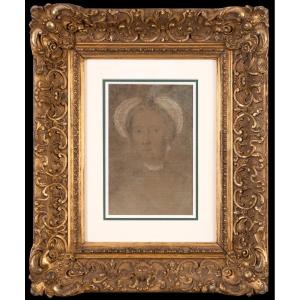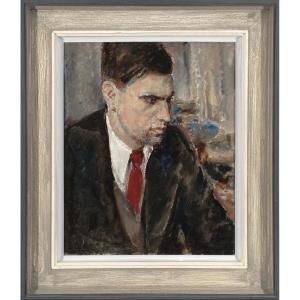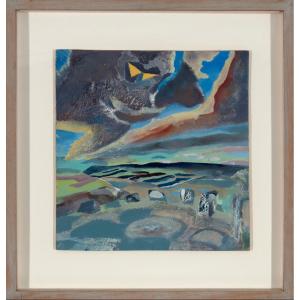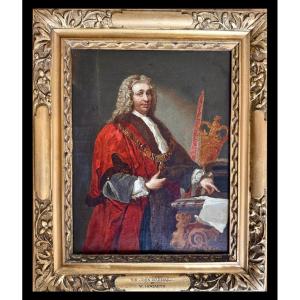Portrait of a lady in widow’s weeds, three-quarter-length, seated in an architectural setting
Oil on canvas
In an original carved and gilded Lely frame
125.2 x 101.7 cm.; (within frame) 143.8 x 119.8 cm.
PROVENANCE
Private collection, United Kingdom;
Christie’s, King Street, where consigned on 25 January 1979; Important English Pictures, 23 March 1979, lot 135 (as Sir Godfrey Kneller);
Sotheby’s, London, Important British Paintings, 6 June 2007, lot 11;
Private collection, United Kingdom.
Painted in three-quarter length, the elegant sitter wears a loose blue silk satin bodice over a white shift, which forms a gentle neckline and opens with gathered under-sleeves at her forearms. Her chestnut hair crowns into curls that fall underneath a long widow’s veil, which she holds to her cheek between clasped fingers. Sitting on a stone seat, she rests her elbow on a tabletop of dupont edge, decorated underneath with a carved acanthus motif that rises into a scrolled support. To her side is a broad pilaster supporting a cartridge encircled with a floral wreath, perhaps the funeral monument of the husband whom she mourns. Heavy silk drapery hangs down from behind and folds across the tabletop. The intimate and contemplative pose is one of Agar used in numerous commissions, such as those of Lady Frances Carteret; Anne Lennox, Duchess Of Richmond And Lennox; and Lady Louise Lennox, Countess Of Berkeley. The work is of the standard dimensions used by d’Agar for three-quarter-length portraits.The work was formerly identified as that of Sir Godfrey Kneller, and a later attribution to Michael Dahl was proposed by Sotheby’s in 2007. While Kneller and Dahl’s work was particularly close, stylistic features of the present work convincingly identify the artist as Charles d’Agar, a close follower of Dahl’s style, as inherited from Kneller himself. A French immigrant portraitist who had come to England with his father Jacques d'Agar, the d'Agars undertook a considerable number of aristocratic commissions.
The historical attribution to Godfrey Kneller was undoubtedly a more immediate answer to the lesser-known Charles d'Agar: as d'Agar never signed his works, mistaken attributions to Kneller are not uncommon. D’Agar’s style followed that of the master, though possessed a gestural manner that was identifiably his own. British portraiture had become dominated by the rapid studio practice introduced from the continent, and Kneller made full use of assistants to sustain a large output, establishing a dominating look known as the ‘Kneller mask’. Whereas other influences including Dahl preferred a gentler subtlety of tonal values and blending, d’Agar’s method is comparatively solid, using opaque and highly contrasted pigment layers shaped with broad defining brushstrokes. D’Agar’s loose working of the sitter’s bodice is characteristic, energetically scored wet-on-wet to create the highlights of the brilliant silk satin. The same is true of the sitter’s softly finished fingers, whose details are shaped with sparing touches. D’Agar’s approach is also typified by the mode of interior decoration. The stone seat and table edges are created with particularly thick pigment worked to a polished gradation. The sculpted table support is of a rising floral kind repeated by d’Agar throughout his works, most similarly in his portraits of Jemima Crewe, Duchess of Kent; Mary, Duchess of Chandos and John, Marquess of Carnarvon; and Barbara Ivory, Mrs. Henry II Davenport.
Charles d'Agar was most likely born in Paris in 1669, the only son of the portrait painter Jacques d'Agar (1642-1715) and his wife Marie Picard. The Protestant Agar family came to England around 1678-81, where Jacques d’Agar’s court commissions included a full-length portrait of Charles II’s French mistress, Louise de Kéroualle, Duchess of Portsmouth. The family traveled to Copenhagen in 1684 to allow Jacques to work at the courts of Christian V and Frederick IV, as a gentleman of the court and painter in ordinary to the king. Charles d'Agar was recorded in Copenhagen with his father between 1686-89, but had returned to London by 1691. Like his father, d'Agar enjoyed success as a court portraitist: by 1707 he was charging £12 for the same size of three-quarter-length portrait as the present work, and his works were often engraved as mezzotints for the London audience. D’Agar’s aristocratic patrons included the Churchill family, of whom he painted John Churchill, 1st Duke of Marlborough; Marlborough’s youngest daughter, Mary, Duchess of Montagu; and two of his granddaughters, Ladies Henrietta and Mary Godolphin. Indeed, the present portrait was owned by the same vendor as a portrait of Sarah Churchill, Duchess of Marlborough, attributed to Kneller; the two were offered together in the Christie’s sale of 1979 and Sotheby’s 2007 sale, selling for £31,200 in the latter. D'Agar committed suicide in London Fields in May 1723, becoming a widow of his wife Susannah. The antiquary George Vertue attended the sale of his prints and drawings, and remembered in his notebooks d’Agar’s popularity with women of the court, though too his violent affliction with taste and stone. Vertue noted that d’Agar left a son who was also a painter, possibly by the name of David.
BIBLIOGRAPHY & FURTHER READING
Ellis Kirkham Waterhouse, Painting in Britiain, 1530 to 1790, 1 vols. (Yale: Yale University Press, 1994)
Ellis Kirkham Waterhouse, The Dictionary of British 18th Century Painters in Oils and Crayons (Woodbridge: Antique Collector’s Club, 1981)




































 Le Magazine de PROANTIC
Le Magazine de PROANTIC TRÉSORS Magazine
TRÉSORS Magazine Rivista Artiquariato
Rivista Artiquariato